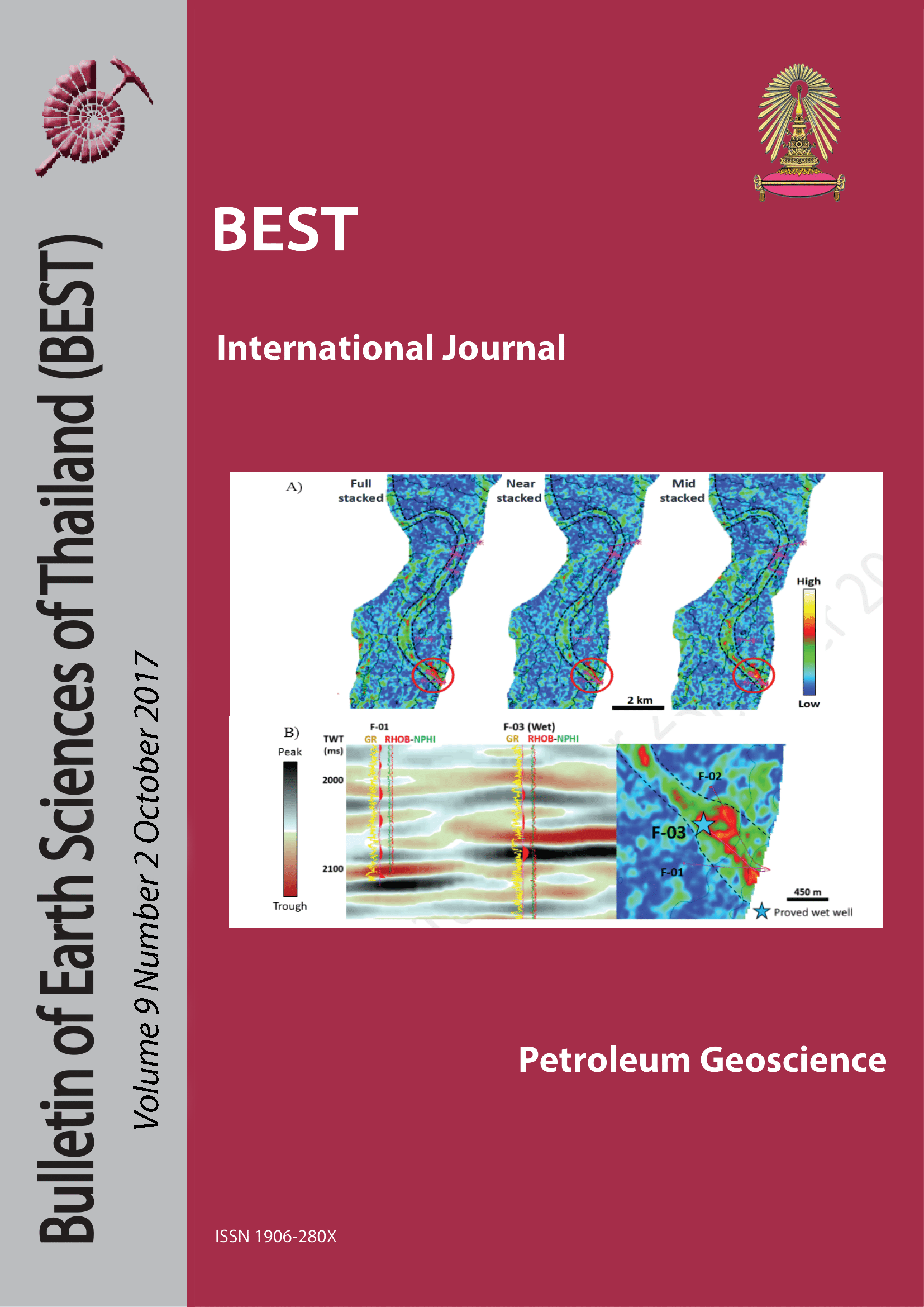THE STUDY OF RESERVOIR DISTRIBUTIONAND CONNECTIVITY USING SEISMIC ATTRIBUTES, CENTRALPATTANI BASIN, GULF OFTHAILAND
Main Article Content
Abstract
Reservoir distribution and connectivity in the Pattani Basin, Gulf of Thailand is always a challenging issue. The reservoirs are relatively thin fluvio-deltaic sands (7-70 ft (2-20 m) on average) and highly compartmentalized by rapid lateral and vertical stratigraphic changes, as well as having an abundance of faults. In order to maximize the production economics, the reservoir connectivity which plays a major role in how the reservoirs are managed and developed must be well understood. This study is aimed to gain a better understanding on reservoir connectivity at 3 sand levels, 3650 ft (1.11 km) (Sand1), 4500 ft (1.37 km) (Sand2) and 7000 ft (2.13 km) (Sand3) true vertical depth sub-sea level (TVDSS). The main 4 possible causes that might result in the not-connected reservoirs among wells are 1) mis-correlated sands, 2) faulted sands 3) internal compartmentalized sands and 4) separated sands. Many seismic attributes were tested to improve fault images. The results of the best fault implication attribute (Variance attribute) showed that there is no major fault amongst well distribution at all 3 sand levels. The sand connectivity study then integrated the Root Mean Square (RMS) amplitude maps that are sand-predictive maps to the well log correlation, pressure data and production-injection data. It revealed that the RMS amplitude can help determine the spatial reservoir distribution, this leads to the more visual reservoir connectivity prediction further to wells without pressure data and/or being perforated. The recommendations for the future sand perforation at Sand1 level and the proposed injector well at Sand3 level have been made to recover the un-swept reserves.
Article Details

This work is licensed under a Creative Commons Attribution-NonCommercial-NoDerivatives 4.0 International License.
Copyright © 2008 Department of Geology, Faculty of Science, Chulalongkorn University. Parts of an article can be photocopied or reproduced without prior written permission from the author(s), but due acknowledgments should be stated or cited accordingly.
References
Gardner, G. H. F., Gardner, L. W., and Gregory, A. R., 1974, Formation Velocity and Densitythe Diagnostic Basics for Stratigraphic Traps, Geophysics, v. 39, p. 770-780.
Gibling, M. R., 2006, Width and thickness of fluvial channel bodies and valley fills in the geological record: A literature compilation and classification: Journal of Sedimentary Research, v. 76, p. 731–770.
Jardine, E., 1997, Dual Petroleum Systems Governing The Prolific Pattani Basin Offshore Thailand, Proceedings of the International Conference on Petroleum Systems of SE Asia and Australasia Conference, May 1997, p. 351-363.
Libo, G., Feng, Z., Yuzhen, W., and Jungang, W., 2016, Analyse on Reservoir Connectivity Constrainted by Seismic Data, SPG/SEG Beijing 2016 International Geophysical Conference.
Morley, C. K., Charusiri, P., and Watkinson, I. M., 2011, Structural geology of Thailand during the Cenozoic, In: Ridd, M. F., Barber, A. J., and Crow, M. J. (eds) The Geology of Thailand: Geological Society of London, p. 273-334.
Shuey, R. T., 1985, A simplification of the Zoeppritz equations, Geophysics, v. 50, no. 4, p. 609-614.
Van Dyke, S. K., 2006, Geoscientific Workflow Process in Drilling a Deepwater Well, Offshore Morocco, In: Annual Bob F. Perkins Research Conference Proceedings, 2006. GCSSEPM Foundation, p. 1233-1256.
Van Dyke, S. K., 2015, Stratal Slicing, An Application for Seismic Sedimentology, International Basic and Applied Research Journal, v. 1, p. 1-6.
Zeng, H., 2010, Stratal Slicing: benefits and challenges, The Leading Edge, v. 29, p. 1040–1047.
Zeng, H., Backus, M. M., Barrow, K. T., and Tyler, N., 1998a, Stratal Slicing, Part I: Realistic 3-D Seismic Model. Geophysics, v. 63, p. 502–513.
Zeng, H., Henry, S. C., and Riola, J. P., 1998b, Stratal Slicing, Part II: Real Seismic Data. Geophysics, v. 63, p. 514–522.


